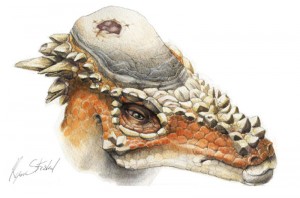This is a post about pachycephalosaurs. It’s not a post about feathered dinosaurs, huge dinosaurs, or any of the ones which you may be more familiar with from popular media. Pachycephalosaurs were the dome-headed little scrappers of the Cretaceous, around 85 to 66 million years ago. Their name means ‘thick-skulled lizard’ (pachy: thick, cephalon: skull, saurus: lizard), and they were a small group within the larger herbivorous group of dinosaurs called ornithischians.
It’s probably fair to say that these dinosaurs are one of the least popular groups; they didn’t have razor sharp teeth and sickle-switchblade claws, they didn’t grow to the size of houses, and they didn’t have rows of armoured shields and spikes along their backs. What they did have, however, is an unusual behaviour that signifies them as unique, and pretty amazing, beasties.

